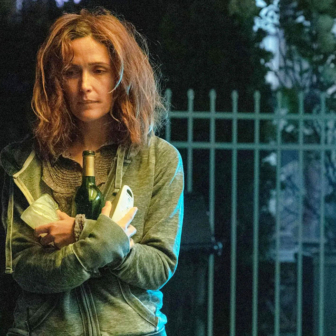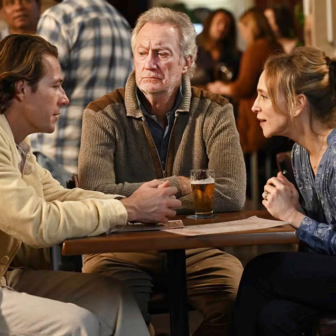The coincidence of the release of Baz Lurhmann’s Australia, with all of the expectations hanging on it, and the debate about the final shape of Screen Australia brought forth a raft of commentary on the state of the local film industry late last year.
For a while it seemed as if just about everyone wanted to say something about film production in Australia, and none of it was complimentary and very little was either hopeful or helpful. Articles and commentary flowed, not only from those whose area of expertise it was, but also from those with little or no previous interest in the subject. While many sweeping declarations were made about the current state of Australian filmmaking, very few really came to terms with the complicated and varied processes that go into both the making of a film and creating a support system for the industry.
Just make good films! If only it were as simple as they imply. But the very process that led to the establishment of Screen Australia on 1 January was concentrated and complicated, encompassing several years and two governments, taking in several reviews, many industry meetings, lots of input from industry groups and individuals, some ministerial statements and discussion papers, and a final round of draft guidelines and filmmaker consultations; a process that finally saw Screen Australia commence operations three weeks ago.
As the various commentators voiced their opinions and an editorial in the Australian decried local films as dark and depressing, an online readers’ poll (also in the Australian) gave the award for the best Australian film ever to Gallipoli, a drama about a dark and depressing moment in the nation’s military history. In a separate category, Australia’s favourite film turned out to be The Castle, which cropped up in a lot of the commentary as the sort of film we ought to be making. Then the AFI Awards, in early December, brought another round of debate – and some drama on stage about media criticism.
A bit of background
Screen Australia is the newly created super-agency which will provide all federal government support to the production sector. Along with the newly bedded-in producer tax rebate (of 40 per cent for feature films and 20 per cent for television productions and documentaries), it is designed to re-energise local production. Arts Minister Peter Garrett says the government is expecting the film industry to “develop commercially focused screen businesses.” He has told filmmakers that they will be supported in developing productions that attract strong financial backing and genuinely appeal to audiences, emphasising that those who work in the industry “must change, look outward to the country and the world and enthusiastically reach out to them on the screen.”
The enormous array of programs conducted by its three component parts, the Australian Film Commission, the Film Finance Corporation and Film Australia, have been amalgamated into a much smaller agenda by Screen Australia. Funding, it says, had been spread much too thinly, and the new policy of making larger amounts of money available to fewer but more experienced producers and projects is a better use of finite resources. Screen Australia will now be responsible for development and production funding for what it calls “a range of audience engaging and culturally relevant” feature films, adult and children’s television drama, documentaries and digital media.
Succeeding in this new environment is going to be a challenge, with much of Screen Australia’s support directed at producers with track records, especially if they also offer assistance to less credentialed filmmakers, and preference given to those with a range and a diversity of projects. The aim is to get Australian audiences interested in Australian films again; after the heady days of Muriel’s Wedding, Priscilla and Crocodile Dundee, when Australian films were taking a substantial slice of the box office, local box office returns have shrunk in recent years to a miserable few per cent.
In fact David Marr, in his round-up of 2008 in Good Weekend last month, described the local industry as “a problem child that never quite grows up.” But for Margaret Pomeranz, writing in the Age a couple of weeks earlier, “all the hoo-ha about Australian films failing to find box-office success, and the assumption that therefore they’re no good, actually evades a lot of the issues confronting our industry.
“After the heady days of the quirky comedies of the early 1990s,” she explained, “the Australian film industry has headed largely into serious territory – and that apparently is not an area into which audiences are willing to follow. And that is a shame. Their performance at the box office was slight in comparison with Muriel’s Wedding, Strictly Ballroom and The Adventures of Priscilla, Queen of the Desert, but who could say that The Boys and Praise are not good films?”
The Age’s film warhorse, Jim Schembri, took a more caustic view on 5 December. “When splendidly written and directed, as with The Jammed and Look Both Ways (which swept the AFIs in 2005), dark themes can make for thrilling cinema,” he wrote. “More often than not, though, this preoccupation with bleak topics and intense character studies about damaged lives is coupled with poorly structured, inert narratives without a third act, and often not even a second… Angst and anguish are fine starting points for any drama, but without character arcs or emotional resolution the films unspool like acting workshops rather than anything intended for an audience.”
He also argued that “lack of marketing has long been a big problem” for local films. “Whereas Americans put plenty of effort into promotion, here it remains an afterthought.” (Once again this is a very simplistic statement; competing with the American films that dominate our box office has always been a very tough ask.)
Miranda Divine, the columnist that the less conservative Sydney Morning Herald readers love to hate, wrote that “so grim and unrewarding have Australian films become, and so dishonestly patriotic the critics about their true worth, that audiences have simply stopped wasting their money.” Over at the Australian, film critic Eddie Cockrell, talking about the new (and as yet unreleased) Australian film Disgrace, said that “in the present climate of this country’s moribund, nervous film industry, where Australian films aren’t so much released as allowed to escape while distracted executives point fingers, a good film is great news. Any movie tragic will tell you that, no question about it.”
The Australian’s 14 November editorial talked about the once “high expectations” of Australian films. “It was something of which the nation was intensely proud, offering great storytelling from quality scripts and cinematography – sometimes confronting, but often uplifting, sophisticated and entertaining.” It argued that “it’s time for much more wit, sophistication, good storytelling and variety. Most of all, it’s time for a depiction of urban life more uplifting than the sorry cannery workers in Peaches, the druggies and dealers, gay and straight and the hookers of Little Fish and Candy, and the dead bodies and dysfunctional characters of Three Dollars, Suburban Mayhem and Jindabyne. While some of these movies – notably Candy – had their strengths, did we really need yet another film about heroin addiction?”
The Australian also took critics to task, arguing that they “must bear some responsibility for the malaise. Despite strings of box office failures, it is difficult, sometimes impossible, to find a biting critique of Australian films. Rather than representing the public paying at the box office, too many critics act as advocates for the film industry. As a result, lured by glowing reviews, cinema-goers will be disappointed, and will not waste scarce leisure time on the next Australian film… [T]he fact is that Australians are not watching Australian movies, and that is something filmmakers should be deeply worried about.”
And even Dominic Knight (from The Chaser), in the Sun Herald in December, could only think “of one successful film that has any connection with the Australia that I grew up in, and that’s Looking for Alibrandi, which is set amid the familiar multicultural tensions of out inner-city suburbs… [I]f you go looking for another Alibrandi, you won’t have much luck, because few of our filmmakers seem interested in depicting ordinary Australian life.”
But Sunday Age film critic Tom Ryan, in his yearly roundup in late December, commented, “while bean counters might deploy box-office returns for locally produced films as their measure for how well the Australian film industry is doing, there are other ways of assessing films’ worth.” And film writer Lynden Barber, in the Australian on 11 October, argued that “we need to get away from the fixation on the box office… in a multi-platform environment it doesn’t matter where people see films as long as they see them.”
An industry in crisis?
The Australian’s film writer Michael Bodey was both more critical and more analytical in his story on the industry on 8 November. “The Australian film industry has lurched from crisis to boom and inexplicably back to crisis throughout its short, erratic history. Moguls including Kerry Packer and Rupert Murdoch and Hollywood studios have come and gone from the industry; locals have lamented a paucity of government funding and mourned the exodus of our best talent overseas.” He wondered whether the new funding model was an improvement. “Is it the model that is the problem anyway? Or can blame for the industry’s under-performance be apportioned to the people drawn to work in its creative branch? In political terms, culture remains a dilemma: there is no correlation, for example, between a vibrant film industry and how the nation votes. On the other hand, film may be an expensive, even elite art form, but it is capable of invigorating national identity.”
And, he asked, “how much can a government film agency or funding structure achieve? Most contemporary thinking suggests results can’t be prescribed by government agencies.”
Bodey argued that we haven’t replicated the era of commercial and global success that produced Strictly Ballroom, Priscilla, Green Card and Muriel’s Wedding, “partly because no one truly understands what brought it about.” He added: “The reasons for Australian cinema’s stasis since the mid-’90s… are many, varied and oft-quoted, including but not limited to: poor script development; the industry’s welfare mentality; a wearying hand-to-mouth existence of film practitioners; inadequate development programs; no meaningful engagement with global distributors; a soft or tough media; clueless film agencies; and too little government funding. But the film industry doesn’t blame itself. Even the audience is at fault, but in cinema’s ongoing hubris, the people who make the films are never at fault.”
Controversial film producer Antony I. Ginnane, whose forty-plus films include ozploitation pics Patrick and Turkey Shoot as well as High Tide and The Lighthorsemen, is back home after fifteen years and was recently and rather surprisingly elected president of the Screen Producers Association of Australia by producers with either forgiving natures or short memories. “Most films lose money,” he said in his keynote address at the association’s conference in November, “but our feature industry of late has been spectacularly unsuccessful.” And, he warned, “If we don’t start connecting with audiences we may be in for a shock. We cannot continue to expect $100 million plus worth of support worth of support a year to be handed over by government if our share of the theatrical box office remains an appallingly low two to three per cent.”
Even the Christian Science Monitor got into the act. Staff writer Stephen Humphries wrote from Los Angeles on 28 November, “before Australian cinema faded into obscurity this century, it seemed to have everything going for it. For starters, the vast but sparsely populated continent has launched a disproportionate number of A-list actors: Mel Gibson, Naomi Watts, Heath Ledger, Russell Crowe, Nicole Kidman, and Cate Blanchett. Australia has produced directors of the calibre of Robert Luketic, Peter Weir, Gillian Armstrong, and Phillip Noyce. And, fittingly for the nation that created the world’s first feature-length film, its cinematic legacy includes Picnic at Hanging Rock, The Man from Snowy River, Muriel’s Wedding, and Shine. Indeed, Babe was so popular worldwide that its talking pig briefly threatened to eclipse the wallaby as Australia’s most famous animal.
“Nowadays,” he went on, “films from Down Under are going, well, down and under. Much of Australia’s top talent has decamped to Hollywood. Antipodal films are rarely screened overseas.” Stating the obvious – “there’s widespread agreement that Australian films need to gear themselves to what audiences want to see” – he added that, “given that the English-speaking nation enjoys American movies, Australian filmmakers face a fundamental quandary: How do you compete with Hollywood films yet still maintain a unique cinematic identity?”
Yet the new chief executive of Screen Australia, Ruth Harley, fresh from a successful stint as head of the NZ Film Commission in a period of strong growth, is remarkably upbeat. She believes 2009 and will be a strong one for Australian film and that there are a number of films in the pipeline that will turn those disappointing box office figures around.
But Jim Schembri, in the Age on 5 December, wrote, “amid the swirl of hype attending the launch two weeks ago of Baz Luhrmann’s wannabe blockbuster Australia, a telling question kept coming up from the local and overseas media. Could this one film be the saviour of the Australian film industry? If it succeeded, would the dire fortunes of our failing film culture go into magical, miraculous, glorious turnaround? It was at once a desperate and silly notion. If the idea of one popular film saving a troubled industry had any traction in reality, Australian cinema would have gone into full bloom after Happy Feet. And after Moulin Rouge. And after The Wog Boy, Crocodile Dundee, The Castle and Crackerjack. It’s a lovely fantasy, but the harsh truth is that hit Australian films are freak events. We celebrate them, but they exist despite the narrow, boutique mindset that equates populism and commercial success with vulgarity and continues to produce films that barely register with the public they are supposed to serve.”
And it is a melancholy fact that after an investment of about $1.5 billion from state and federal governments over more than thirty years, Australian films earn less at the box office now than ever in that time, although investment in film is still substantial: in 2007–08, the first year of new federal tax breaks, there was a 7 per cent rise in the money spent on film and television production to $675 million, mainly boosted by a rise in imported productions, foreign co-productions and TV dramas, according to Screen Australia’s 2007–08 Drama Production Survey.
The films nominated for best film at the AFI Awards – The Jammed, The Black Balloon, The Square and Unfinished Sky – combined to take about $3.9 million at the box office. “For a far more disturbing gauge of the film industry’s peril, however,” commented Jim Schembri, “compare that four-film box office figure with the $7 million budget for the Australian film The Tender Hook, a period film set in Sydney during the jazz age. It’s a film almost nobody has heard of. And no wonder. Its take at the ticket counter? Less than $40,000! Yet somehow this box office catastrophe has slipped by with virtually no comment, when it should have sounded a five-alarm warning. If anything signals the industry is in deep trouble it’s that it can casually produce such a monumental failure without anybody raising an eyebrow or being held to account.”
The drama at the AFI Awards
Accepting the award for best original screenplay for The Black Balloon, co-writer Jimmy Jack singled out Schembri for the tone of many of his reviews and opinions, reading out some excerpts and ending “Jim Schembri – fuck you!” There was much applause, but the comment and its response was cut from the telecast by Channel Nine.
A pained Schembri wrote in his blog the next day – “That such abuse drew applause reflected an industry comfortable with its insular, anti-audience attitude. Sure, everybody loves a good ‘Stick it to The Man’ moment – but this wasn’t that. Gestures of defiance against critics only mean anything if there is something in the criticism to fault. Australian films have virtually no connection with Australian audiences. That those films are funded by the audience verges on cultural disgrace. The occasional hits – the Muriels, the Priscillas, the Kennys – are invariably one-offs. Now, while taking pot shots at the messenger might make good, momentary sport it doesn’t make the message go away – especially when the message is so screamingly obvious… Lambasting the media for merely reporting the truth has been a major preoccupation for some figures in the film industry, and the appeal is clear. It serves as a diversionary tactic designed to shift focus from the elephant in the room.”
Schembri argued that “the film component of the AFI Award ceremony on Saturday night was a concert of denial that bordered on farce. The glitter, the glamour, the red carpets, the fans, the paparazzi, the sheer scale of the event simply did not match the borderline relevance Australian cinema has to its audience.”
So what are we to make of all this? Probably not very much. It’s really just another, if more extensive, episode of what has been a rather regular event, the media getting stuck into Australian films and filmmaking. It would be more valuable if the debate reached some sound and achievable conclusions, but it never really does. So many years, so much money, so many highs, and recently, so many more lows – this must indicate that the whole business is a lot more complex and much harder to get right than what seems to come through much of the commentary: “You are making the wrong kind of movies!”
Michael Bodey asks whether the new structure is right; I’d also ask whether the priorities are right. Everyone agrees that the basic issue is getting Australian films to connect with Australian audiences again, but to do that, it would probably help to find out why they currently don’t. We need to find out more about audiences – their tastes and motivations. We do know, for example, that younger audiences have many other things to do apart from watching films. A number of the films the commentators have labelled “dark and depressing” and therefore not worth seeing, have actually been good films and well worth seeing – so why didn’t they reach an audience?
We know that Australian cinema has always had to struggle in a market dominated by Hollywood, and that the production and distribution of Australian films has always been difficult against such strong and determined competition. A relatively small population doesn’t help. The problem isn’t only ours; worldwide, more films than ever are being made, more are reaching cinemas, but they are given even less time to reach and connect with an audience.
Screen Australia has a stated commitment to marketing, distribution and that ill-defined but essential aspect of a healthy film community, screen culture, but it is only now about to look at what role it will play and what it will support in these areas. The decisions made will be as important to the future of film in Australia as any made about production support; let’s hope the debates and discussions leading up to those decisions are serious, detailed, and very well-informed. •




